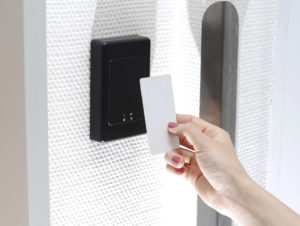
The right access control system entails the right credentials for whatever your situation is.
Determining your facility’s access control needs often requires taking a look at what security vulnerabilities may be and how employees or guests interact with the building. You may be worried about hindering daily foot traffic too much, leaving gaps in your security, or simply not covering your bases, but there are a number of access control systems out there. There are different kinds of credentials out there and one of the most commonly utilized are different kinds of cards. Below, we break down some of the most common access control credentials and what the different kinds of cards are capable of.
1. Traditional Key Cards
Old school key cards have been around for quite a while and their simplicity makes them appealing for basic access control applications. They can be easily attached to a belt or worn on a lanyard around the neck and typically work like already-familiar technologies, like credit cards. This is because like a credit card, they’re either swiped or inserted at the time of use and the credentials of the user are matched against a database. If they have the correct credentials, they are granted access. One downside to cards that are swiped is that they can wear down from regular use or even become demagnetized just like any other card you may swipe.
2. Proximity
A quicker option for end-users, albeit more expensive, are proximity cards. These take advantage of radio frequencies allowing them to be used just by being placed near a scanner which can then check for credentials at a distance. Like regular key cards, proximity cards are usually capable of “read-only” technology, which makes them suitable only for simple tasks. It also has a slight learning curve, as users end up having to discover what the right distance between the card and the reader is.
3. Active Prox Cards
If you’re worried about struggling to get prox cards to read, active prox cards could be a good solution. They’re powered by an internal lithium battery which allows for a bit more flexibility when it comes to getting the card to register. Because they have a battery, their lifespan typically only lasts around five years. It’s also a more costly technology, but that’s a trade-off for a more flexible technology.
4. Smart Cards
Contactless smart cards are similar to active prox cards but can hold even more information. This includes biometric templates, attendance data, and timestamps, which makes monitoring what employees are up to a breeze. As far as features go, contactless smart cards are the most robust in what they can offer.
Get in Touch with FiberPlus
FiberPlus has been providing data communication solutions for over 25 years in the Mid Atlantic Region for a number of different markets. What began as a cable installation company for Local Area Networks has grown into a leading provider of innovative technology solutions improving the way our customers communicate and keeping them secure. Our solutions now include:
- Structured Cabling (Fiberoptic, Copper and Coax for inside and outside plant networks)
- Electronic Security Systems (Access Control & CCTV Solutions)
- Wireless Access Point installations
- Public Safety DAS – Emergency Call Stations
- Audio/Video Services (Intercoms and Display Monitors)
- Support Services
- Specialty Systems
- Design/Build Services
FiberPlus promises the communities in which we serve that we will continue to expand and evolve as new technology is introduced within the telecommunications industry.
Have any questions? Interested in one of our services? Call FiberPlus today 800-394-3301, email us at info@fiberplusinc.com, or visit our contact page. Our offices are located in the Washington, DC metro area, Richmond, VA, and Columbus, OH. In Pennsylvania, please call Pennsylvania Networks, Inc. at 814-259-3999.
Do you enjoy clicking “Like” and “Follow?” Be sure to click on our official Pinterest, Facebook, Twitter, and LinkedIn pages today!